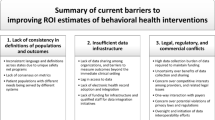Abstract
While the Health Information Technology for Economic and Clinical Health Act, enacted as part of the American Recovery and Reinvestment Act of 2009, provided $20.6 billion for incentive payments to support the adoption and meaningful use of health information technology (HIT), behavioral health organizations were not eligible to receive facility payments. The consequences of excluding behavioral health from HIT incentive payments are found in the results of the "HIT Adoption and Meaningful Use Readiness in Community Behavioral Health" survey. The survey found that only 2% of community behavioral health organizations are able to meet federal meaningful use (MU) requirements—compare this to the 27% of Federally Qualified Health Centers and 20% of hospitals that already meet some level of MU requirements. Behavioral health organizations, serving more than eight million adults, children, and families with mental illnesses and addiction disorders, are ready and eager to adopt HIT to meet the goals of better healthcare, better health, and lower costs. But reaching these goals may prove impossible unless behavioral health achieves "parity" within healthcare and receives resources for the adoption of HIT.
Similar content being viewed by others
References
Daschle T. 70 Yards to the health reform touchdown. National Council Magazine 2012; 1:8–11. Available online at gallery/12_NCCBH%20magazine%231_web.pdf. Accessed August 10, 2012.
Centers for Medicare & Medicaid Services. CMS EHR Meaningful Use Overview. Available online at https://www.cms.gov/Regulations-and-Guidance/Legislation/EHRIncentivePrograms/Meaningful_Use.html. Accessed August 12, 2012.
Department of Health and Human Services, Centers for Medicare & Medicaid Services. American Recovery and Reinvestment Act. Medicare and Medicaid Incentives and Administrative Funding. Available online at http://www.hhs.gov/recovery/programs/index.html#Health. Accessed August 10, 2012.
National Council for Community Behavioral Healthcare. Hit Adoption and Readiness for Meaningful Use in Community Behavioral Health: Report on the 2012 National Council Survey. Washington, D.C. National Council for Community Behavioral Healthcare, June 2012. Available online at http://www.thenationalcouncil.org/galleries/business-practice%20files/HIT%20Survey%20Full%20Report.pdf. Accessed August 10, 2012.
S. 539: Behavioral Health Information Technology Act of 2011. Govtrack.us, 112th Congress, 2011–2012. Available online at http://www.govtrack.us/congress/bills/112/s539/text. Accessed August 12, 2012.
Bartels S, Desilets R. Health Promotion Programs for People with Serious Mental Illness: What Works. Washington, D.C. SAMHSA-HRSA Center for Integrated Health Solutions, January 2012. Available online at http://www.integration.samhsa.gov/Health_Promotion_White_Paper_Bartels_Final_Document.pdf. Accessed August 10, 2012.
Author information
Authors and Affiliations
Corresponding author
Rights and permissions
About this article
Cite this article
Rosenberg, L. HIT: Time to End Behavioral Health Discrimination. J Behav Health Serv Res 39, 336–338 (2012). https://doi.org/10.1007/s11414-012-9297-8
Published:
Issue Date:
DOI: https://doi.org/10.1007/s11414-012-9297-8




